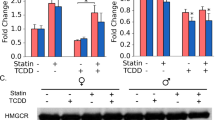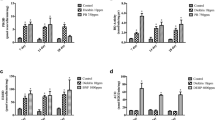Abstract
ortho-Aminoazotoluene (o-AT) is a potent hepatocarcinogen for most mouse strains. Previously, it has been shown that oAT administration activates the aryl hydrocarbon receptor (Ahr) and the constitutive androstane receptor (Car) in the mouse liver. Both receptors are directly involved in hepatocarcinogenesis. In this study, we investigated the effect of chronic o-AT administration on the mRNA expression levels of Ahr, Car, and their target genes Cyp1a1 and Cyp2b10, as well as the correlation of their expression with the degree of inflammatory response in the mouse strains DD/He (DD) and CC57BR/Mv (BR), which are contrasting in their sensitivity to hepatocarcinogenesis. Male mice of both strains received the o-AT oil solution at a dose of 225 mg/kg body weight four times within two months. Control animals received the equivalent solvent amount. The mice were sacrificed after 1 and 4 days since the last o-AT administration. The gene expression levels in the liver were determined by real-time PCR. The inflammatory response was evaluated by the serum concentration of the tumor necrosis factor alpha (TNFα). In resistant BR mice, the o-AT administration induced a more pronounced and prolonged increase in the Cyp1a1 mRNA, indicating the preferential Ahr activation in these animals. At the same time a more pronounced increase in the Cyp2b10 expression level in the sensitive DD mice was observed, suggesting the Car activation. In addition, a strong and prolonged inflammatory response to o-AT administration was noted in the DD mice, but not in BR. It is assumed that the prevalence of the Ahr signaling pathway activation over the Car signaling pathway activation is a factor of the resistance to o-AT-induced hepatocarcinogenesis.
Similar content being viewed by others
References
Baginskaya, N.V., Ilnitskaya, S.I., Nikitenko, E.V., and Kaledin, V.I., The promoting effect of ortho-aminoazotoluene on hepatocarcinogenesis is accompanied by increased inflammation and proliferative processes in liver tissue and decrease in concentration of free thyroxine in blood, Byul. Eksp. Biol. Med., 2007, vol. 144, no. 12, pp. 672–676.
Baginskaya, N.V., Perepechaeva, M.L., Khoshchenko, O.M., and Dushkin, M.I., Influence of ortho-aminoazotoluene on expression of genes PPAR-αa, PPAR-α, RXR-α, and CAR in liver and levels of IL-1β in blood of mice contrast in terms of sensitivity to chemical hepatocarcinogenesis of strains, in Retseptsiya i vnutrikletochnaya signalizatsiya (Reception and Intracellular Signaling), Pushchino, 2009, pp. 1326–1330.
Beigneux, A.P., Moser, A.H., Shigenaga, J.K., Grunfeld, C., and Feingold, K.R., Reduction in cytochrome P-450 enzyme expression is associated with repression of CAR (constitutive androstane receptor) and PXR (pregnane X receptor) in mouse liver during the acute phase response, Biochem. Biophys. Res. Commun., 2002, vol. 293, pp. 145–149.
Chen, C.J. and Chen, D.S., Interaction of hepatitis B virus, chemical carcinogen, and genetic susceptibility: Multistage hepatocarcinogenesis with multifactorial etiology, Hepatology, 2002, vol. 36, pp. 1046–1049.
Cheung, Y.L., Puddicombe, S.M., Gray, T.J., and Ioannides, C., Mutagenicity and CYP1A induction by azobenzenes correlates with their carcinogenicity, Carcinogenesis, 1994, vol. 15, pp. 1257–1263.
Fan, Y., Boivin, G.P., Knudsen, E.S., Nebert, D.W., Xia, Y., and Puga, A., The aryl hydrocarbon receptor functions as a tumor suppressor of liver carcinogenesis, Cancer. Res., 2010, vol. 70, pp. 212–220.
Feo, F., de Miglio, M.R., Simile, M.M., Muroni, M.R., Calvisi, D.F., Frau, M., and Pascale, R.M., Hepatocellular carcinoma as a complex polygenic disease. Interpretive analysis of recent developments on genetic predisposition, Biochim. Biophys. Acta, 2006, vol. 1765, pp. 126–147.
Gerbal-Chaloin, S., Iankova, I., Maurel, P., and Daujat-Chavanieu, M., Nuclear receptors in the cross-talk of drug metabolism and inflammation, Drug Metab. Rev., 2013, vol. 45, no. 1, pp. 122–144.
Glass, C.K. and Saijo, K., Nuclear receptor transrepression pathways that regulate inflammation in macrophages and T cells, Nat. Rev. Immunol., 2010, vol. 10, pp. 365–376. doi 10.1038/nri2748
Hanieh, H., Toward understanding the role of aryl hydrocarbon receptor in the immune system: Current progress and future trends, Biomed. Res. Int., 2014. doi 10.1155/2014/520763
Huang, W., Zhang, J., Washington, M., Liu, J., Parant, J.M., Lozano, G., and Moore, D.D., Xenobiotic stress induces hepatomegaly and liver tumors via the nuclear receptor constitutive androstane receptor, Mol. Endocrinol., 2005, vol. 19, pp. 1646–1653.
Kaledin, V.I., Serova, I.A., and Semenova, L.A., Unequal predisposition to develop spontaneous and induced liver tumors in mice of different lines and their hybrids, Eksp. Onkol., 1990, vol. 12, no. 4, pp. 28–30.
Kaledin, V.I. and Ilnitskaya, S.I., Metabolic inhibition stimulates and metabolic activation inhibits the carcinogenic effect of ortho-aminoazotoluene on mice liver, Vopr. Onkol., 2011, vol. 57, pp. 216–220.
Kolaya, K.L., Stevenson, D.E., Walborg, E.F., and Klaunig, J.E., Cancer biology: Dose dependence of phenobarbital promotion of preneoplastic hepatic lesions in F344 rats and B6C3F1 mice: Effects on DNA synthesis and apoptosis, Carcinogenesis, 1995, vol. 17, pp. 947–954.
Liedtke, C. and Trautwein, C., The role of TNF and Fas dependent signaling in animal models of inflammatory liver injury and liver cancer, Eur. J. Cell Biol., 2012, vol. 91, nos. 6–7, pp. 582–589. doi 10.1016/j.ejcb.2011.10.001
Marlowe, J.L. and Puga, A., Aryl hydrocarbon receptor, cell cycle regulation, toxicity, and tumorigenesis, J. Cell Biochem., 2005, vol. 96, pp. 1174–1184.
Mikhailova, O.N., Vasyunina, E.A., Ovchinnikova, L.P., Gulyaeva, L.F., Timofeeva, O.A., Filipenko, M.L., and Kaledin, V.I., O-Aminoazotoluene does induce the enzymes of its own mutagenic activation in mouse liver, Toxicology, 2005, vol. 211, pp. 132–138.
Miller, E.C. and Miller, J.A., Searches for ultimate chemical carcinogens and their reactions with cellular macromolecules, Cancer, 1981, vol. 47, no. 10, pp. 2327–2345.
Mitchell, K.A., Lockhart, C.A., Huang, G., and Elferink, C.J., Sustained aryl hydrocarbon receptor activity attenuates liver regeneration, Mol. Pharmacol., 2006, vol. 70, no. 1, pp. 163–170.
Moennikes, O., Loeppen, S., Buchmann, A., Andersson, P., Ittrich, C., Poellinger, L., and Schwarz, M.A., A constitutively active dioxin/aryl hydrocarbon receptor promotes hepatocarcinogenesis in mice, Cancer Res., 2004, vol. 64, pp. 4707–4710.
Nakagawa, H. and Maeda, S., Inflammation-and stressrelated signaling pathways in hepatocarcinogenesis, World J. Gastroenterol., 2012, vol. 18, no. 31, pp. 4071–4081.
Nebert, D.W., Dalton, T.P., Okey, A.B., and Gonzalez, F.J., Role of aryl hydrocarbon receptor-mediated induction of the CYP1 enzymes in environmental toxicity and cancer, J. Biol. Chem., 2004, vol. 279, pp. 23847–23850.
Patel, R.D., Hollingshead, B.D., Omiecinski, C.J., and Perdew, G.H., Aryl-hydrocarbon receptor activation regulates constitutive androstane receptor levels in murine and human liver, Hepatology, 2007, vol. 46, pp. 209–218.
Petrick, J.S. and Klaassen, C.D., Importance of hepatic induction of constitutive androstane receptor and other transcription factors that regulate xenobiotic metabolism and transport, Drug Metab. Dispos., 2007, vol. 35, no. 10, pp. 1806–1815.
Smetanina, M.A., Pakharukova, M.Y., Kurinna, S.M., Dong, B., Hernandez, J.P., Moore, D.D., and Merkulova, T.I., Ortho-aminoazotoluene activates mouse constitutive androstane receptor (mCAR) and increases expression of mCAR target genes, Toxicol. Appl. Pharmacol., 2011, vol. 255, pp. 76–85.
Tian, Y., Ke, S., Denison, M.S., Rabson, A.B., and Gallo, M.A., Ah receptor and NF-kappaB interactions, a potential mechanism for dioxin toxicity, J. Biol. Chem., 1999, vol. 274, pp. 510–515.
Timofeeva, O.A., Filipenko, M.L., Rykova, N.A., Gulyaeva, L.F., and Lyakhovich, V.V., Expression of CYP1A in liver of mice of strains A/SN and CC57BR differing in their sensitivity to the action of hepatocarcinogenic action of o-aminoazotoluene, Biokhimiya, 2000, vol. 65, no. 6, pp. 842–847.
Vogel, C.F. and Matsumura, F., A new cross-talk between the aryl hydrocarbon receptor and RelB, a member of the NF-kappaB family, Biochem. Pharmacol., 2009, vol. 77, pp. 734–745.
Xie, W., Yeuh, M.F., Radominska-Pandya, A., Saini, S.P., Negishi, Y., Bottroff, B.S., Cabrera, G.Y., Tukey, R.H., and Evans, R.M., Control of steroid, heme, and carcinogen metabolism by nuclear pregnane X receptor and constitutive androstane receptor, Proc. Natl. Acad. Sci. U.S.A., 2003, vol. 100, pp. 4150–4155.
Yamamoto, Y., Moore, R., Goldsworthy, T.L., Negishi, M., and Maronpot, R.R., The orphan nuclear receptor constitutive active androstane receptor is essential for liver tumor promotion by phenobarbital in mice, Cancer Res., 2004, vol. 64, no. 20, pp. 7197–7200.
Zacharova, L.Yu., Gulyaeva, L.F., Lyakhovich, V.V., Mikhailova, O.N., Timofeeva, O.A., Filipenko, M.L., and Kaledin, V.I., Cytochrome P4501A1 and 1A2 gene expression in the liver of 3-methylcholanthrene-and o-aminoazotoluene-treated mice: A comparison between PAHresponsive and PAH-nonresponsive strains, Toxicol. Sci., 2003, vol. 73, pp. 108–113.
Author information
Authors and Affiliations
Corresponding authors
Additional information
Original Russian Text © N.V. Baginskaya, E.V. Kashina, M.Yu. Shamanina, S.I. Ilnitskaya, V.I. Kaledin, V.A. Mordvinov, 2015, published in Vavilovskii Zhurnal Genetiki i Selektsii, 2015, Vol. 19, No. 4, pp. 474–479.
Rights and permissions
About this article
Cite this article
Baginskaya, N.V., Kashina, E.V., Shamanina, M.Y. et al. Correlation of susceptibility to ortho-aminoazotoluene-induced hepatocarcinogenesis with Car and Ahr signaling pathway activation in mice. Russ J Genet Appl Res 6, 463–468 (2016). https://doi.org/10.1134/S2079059716040043
Received:
Accepted:
Published:
Issue Date:
DOI: https://doi.org/10.1134/S2079059716040043




